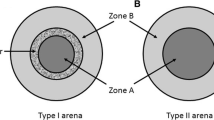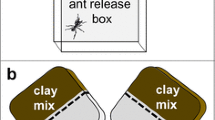Abstract
There are several types of potential hazards associated with the use of pesticides, among them, soil contamination during their underground application. The trade-off between control effectiveness and soil contamination can be observed during the control of leaf-cutting ants using thermal fogs in South American agricultural and forest plantations. This work was aimed at simultaneously assessing fog penetration into the soil around the application point, as a measure of contamination, and fog presence inside nest chambers of the grass-cutting ant Atta capiguara, as a measure of control effectiveness. For that, we have implanted fog sensors both into the soil around the application point and inside fungus chambers. Results showed that thermal fogging can be considered as an effective way for controlling leaf-cutting ants, since fog actually entered into the fungus chambers of A. capiguara after an average of 7 min. Nevertheless, after 3 min, i.e. long before reaching the fungus chambers, fog penetrated laterally 0.5 m into the soil, and at a depth of 1 m. At the time the fungus chambers were reached, the fog extended over 1.5 m across the soil. Thus, assuming a radial spread of fog, the total volume of contaminated soil around the application point averaged almost one cubic meter. Given the need of using thermal fogging for the control of Atta leaf-cutting ants due to both the economic damage they produce and the lack of other effective control methods under particular circumstances, associated environmental costs of thermal fogging as well as possible mitigation measures are discussed.






Similar content being viewed by others
References
Amante E (1964) Nota prévia sôbre a estrutura do ninho de uma nova formiga saúva (Atta sp.) (Hymenoptera, Formicidae). O Biológico 30:96–97
Andrade APP, Forti LC, Roces F, Camargo R, Verza SS (2005) Arquitetura interna do ninho de Atta capiguara Gonçalves 1944 (Hymenoptera: Formicidae). XVII Simpósio de Mirmecologia, Campo Grande, pp 490–493
Bollazzi M, Forti LC, Roces F (2012) Ventilation of the giant nests of Atta leaf-cutting ants: does underground circulating air enter the fungus chambers? Insectes Sociaux 59:487–498
Bünemann EK, Schwenke GD, Van Zwieten L (2006) Impact of agricultural inputs on soil organisms—a review. Aust J Soil Res 44:379–406
Cherrett JM (1986a) Chemical control and bait formulation for leaf-cutting ants. In: Lofgren CS, Vander Meer RK (eds) Fire ants and leaf-cutting ants—biology and management. Westview Press, Boulder, pp 357–360
Cherrett JM (1986b) History of the leaf-cutting ant problem. In: Lofgren CS, Vander Meer RK (eds) Fire ants and leaf-cutting ants—biology and management. Westview Press, Boulder, pp 10–17
Conover WJ (1999) Practical nonparametric statistics, 3rd edn. Wiley, New York
Cope OB (1971) Interactions between pesticides and wildlife. Annu Rev Entomol 16:325–364
De Souza RB, Maziviero TG, Christofoletti CA, Pinheiro TG, Fontanetti CS (2013) Soil contamination with heavy metals and petroleum derivates: impact on edaphic fauna and remediation strategies. In: Hernandez Soriano MC (ed) Soil processes and current trends in quality assessment. Intech, Rijeka. doi:10.5772/52868
Dramic DM, Ciric IS (1996) Dominant reactions and degree of doping of commercial carbon monoxide sensors. Meas Technol 39:1131–1135
Embrapa (2006) Sistema brasileiro de clasificação dos solos. Empresa Brasileira de Pesquisa Agropecuária. Embrapa Solos. Ministério da Agricultura, Pecuária e Abastecimento. Brasil
Embrapa (2013) Caledario de solos 2013. Empresa Brasileira de Pesquisa Agropecuária. Embrapa Solos. Ministério da Agricultura, Pecuária e Abastecimento. Brasil
Forti LC (1985) Ecologia da atividade forrageira da saúva, Atta capiguara Gonçalves, 1944 (Hymenoptera: Formicidae), e seu impacto em pastagem. Dissertation. Escola Superior de Agricultura Luiz de Queiroz-USP. Piracicaba
Forti LC, Boaretto MAC (1997) Formigas Cortadeiras—Biologia, Ecologia, Danos e Controle. UNESP, Botucatu
Forti LC, Nagamoto NS, Pretto DR (1998) Controle de formigas cortadeiras com isca granulada. In: Filho EB, Assis Menezes Mariconi F, de, Fontes LR (eds) As Formigas Cortadeiras dos Países do Mercosul. FEALQ (Fundação de Estudos Agrários Luiz de Queiroz), Piracicaba, pp 113–132
Forti LC, Pretto DR, Nagamoto NS, Padovani CR, Camargo RS, Andrade APP (2007) Dispersal of the delayed action insecticide sulfluramid in colonies of the leaf-cutting ant Atta sexdens rubropilosa (Hymenoptera: Formicidae). Sociobiology 50:1149–1163
Fowler HG, Forti LC, Pereira-da-Silva V, Saes NB (1986) Economics of grass-cutting ants. In: Lofgren CS, Vander Meer RK (eds) Fire ants and leaf-cutting ants—biology and management. Westview Press, Boulder, pp 18–35
Gardner JW (1989) Electrical conduction in solid-state gas sensors. Sens Actuators 18:373–387
Gonçalves CR (1944) Descrição de uma nova saúva brasileira (Hym., Form.). Rev Bras Biol 4:233–238
Hillel D (1998) Environmental soil physics. Academic Press, London
Hoffmann WC, Walker TW, Fritz BK, Gwinn T, Smith VL, Szumlas D, Quinn B, Lan Y, Huang Y, Sykes D (2008) Spray characterization of thermal fogging equipment typically used in vector control. J Am Mosq Control Assoc 24:550–559
Jacoby M (1935) Erforschung der Struktur des Atta-Nestes mit Hilfe des Cementausguss-Verfahrens. Rev Entomol 5:420–424
Jaffe K (1986) Control of Atta and Acromyrmex in pine tree plantations in the Venezuela Llanos. In: Lofgren CS, Vander Meer RK (eds) Fire ants and leaf-cutting ants—biology and management. Westview Press, Boulder, pp 123–145
Jonkman JCM (1980) The external and internal structure and growth of nests of the leaf-cutting ant Atta vollenweideri Forel, 1893 (Hym.: Formicidae). Part II. The internal nest structure and growth. Z ang Entomol 89:217–246
Kleineidam C, Ernst R, Roces F (2001) Wind induced ventilation of the giant nests of the leaf-cutting ant Atta vollenweideri. Naturwissenschaften 88:301–305
Knapp JJ, Howse PE, Kermarrec A (1990) Factors controlling foraging patterns in the leaf-cutting ant Acromyrmex octospinosus (Reich). In: Vander Meer RK, Jaffé K (eds) Applied myrmecology—a world perspective. Westview Press, Boulder, pp 382–409
Locke MA, Zablotowicz RM (2004) Pesticides in soil—benefits and limitations to soil health. In: Christensen BT, Elmholt S, Schjonning P (eds) Managing soil quality: challenges in modern agriculture. CABI Publishing, Wallingford, pp 239–260
Mariconi FAM (1970) As saúvas. Agronômica Ceres, São Paulo
Mariconi FAM, Zamith APL, Paiva Castro U (1961) Contribuição para o conhecimento da saúva parda Atta capiguara Gonçalves, 1944. Anais da Escola Superior de Agricultura ‘Liuz de Queiroz’, Piracicaba 18:301–312
Marques F, Calegari M, Vidal-Torrado P, Buurman P (2011) Relationship between soil oxidizable carbon and physical, chemical and mineralogical properties of umbric ferralsols. R Bras Sci Solo 35
Montoya-Lerma J, Giraldo-Eceverri C, Armbrecht I, Farji-Brener AG, Calle Z (2012) Leaf-cutting ants revisited: towards rational management and control. Int J Pest Manag 58:225–247
Moreira AA, Forti LC, Boaretto MAC, Andrade APP, Lopes JFS, Ramos VM (2004a) External and internal structure of Atta bisphaerica Forel (Hymenoptera: Formicidae) nests. J Appl Entomol 128:204–211
Moreira AA, Forti LC, de Andrade APP, Castellani Boaretto MA (2004b) Architecture of nests of the Atta laevigata (F. Smith, 1858) (Hymenoptera: Formicidae). Stud Neotrop Fauna Environ 39:109–116
Nagamoto NS, Forti LC, Raetano CG (2007) Evaluation of the adequacy of diflubenzuron and dechlorane in toxic baits for leaf-cutting ants (Hymenoptera: Formicidae) based on formicidal activity. J Pest Sci 80:9–13
Nickele M, Reis-Filho W, Batista E, Tadeu E, Caldato N, Strapasson P (2012) Leaf-cutting ant attack in initial pine plantations and growth of defoliated plants. Pesq Agr Bras 47:892–899
Perez P, Corley J, Farji-Brener AG (2011) Potential impact of the leaf-cutting ant Acromyrmex lobicornis on conifer plantations in northern Patagonia, Argentina. Agric For Entomol 13:191–196
Perry AS, Yamamoto I, Iishaaya I, Perry R (1997) Insecticides in agriculture and environment: retrospects and prospects. Springer Verlag, Berlin
Reid BL, Klotz JH (1992) Oral toxicity of abamectin, dechlorane, and sulfluramid to free-foraging workers of Camponotus pennsylvanicus (Hymenoptera: Formicidae). J Econ Entomol 85:1822–1829
Reis-Filho W, dos Santos F, Strapasson P, Nickele M (2011) Damage caused by different levels of artificial defoliation, simulating the leaf-cutting ants attack on young plantations of Pinus taeda and Eucalyptus grandis. Pesq Flor Bras 31:37–42
Roces F, Bollazzi M (2009) Information transfer and the organization of foraging in grass- and leaf-cutting ants. In: Jarau S, Hrncir M (eds) Food exploitation by social insects, ecological behavioral and theoretical approaches. CRC Press, Boca Raton, pp 251–264
Saverscheck N, Herz H, Wagner M, Roces F (2010) Avoiding plant unsuitables for the symbiotic fungus: learning and long-term memory in leaf-cutting ants. Anim Behav 79:689–698
Souza A, Zanetti R, Calegiaro N (2011) Economic damage Level for leaf-cutting ants in function of the productivity index of Eucalyptus plantations in an Atlantic forest region. Neotrop Entomol 40:483–488
Wagenet RJ, Hutson JL (1990) Quantifying pesticide behavior in soil. Annu Rev Phytopathol 28:295–319
Watson J (1984) The tin oxide gas sensor and its applications. Sens actuators 5:29–42
Weber NA (1972) Gardening ants—the attines. The American Philosophical Society, Philadelphia
Wirth R, Herz H, Ryel RJ, Beyschlag W, Hölldobler B (2002) Herbivory of leaf-cutting ants—a case study on Atta colombica in the tropical rainforest of Panama. Ecological studies, vol 164. Springer, Berlin
Zanetti R, Dias N, Reis M, Souza-Silva A, Alves-Moura M (2004) Eficiência de iscas granuladas (sulfluramida 0,3%) no controle de Atta sexdens rubropilosa Forel, 1908 (Hymenoptera:Formicidae). Ciênc agrotec 28:878–882
Zanetti R, Zanuncio JC, Souza-Silva A, Aparecida Mendonca L, Souza Mattos JO, Rizental MS (2008) Eficiência de produtos termonebulígenos no controle de Atta laevigata (Hymenoptera: Formicidae) em plantio de eucalipto. Ciênc agrotec 32:1313–1316
Acknowledgments
We thanks Angel Vidal (Univ. Buenos Aires) for developing and constructing the propane-datalogger, to Scott Turner (SUNY-ESF, Syracuse) for advice on propane sensors, and to Prof. Maria Helena Moraes-Instituto do Solo, UNESP, for soil analysis. This study was performed in the framework of the co-operation agreement between the UNESP-Botucatu and the University of Würzburg (Ref. 910-2007). Financial support was provided by funds from the German Research Foundation (DFG, grant SFB 554/TP E1), the São Paulo State Research Foundation FAPESP (2008/05434-0; 2010/00204-7), and the Brazilian National Research Council CNPq (4726712008-1).
Author information
Authors and Affiliations
Corresponding author
Additional information
Communicated by K.J. Gorman
Rights and permissions
About this article
Cite this article
Bollazzi, M., Forti, L.C., Moreira, S. et al. Efficiency and soil contamination during underground application of insecticides: control of leaf-cutting ants with thermal foggers. J Pest Sci 87, 181–189 (2014). https://doi.org/10.1007/s10340-013-0525-7
Received:
Accepted:
Published:
Issue Date:
DOI: https://doi.org/10.1007/s10340-013-0525-7




